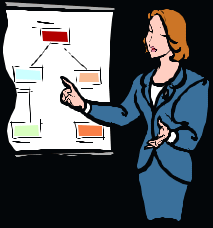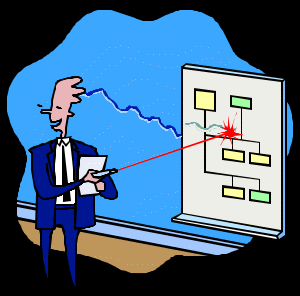|
|
Англ. Essential Business English Practice (магистрат. Практикум по основам делового общения на английском языке учебное пособие
MAKING PRESENTATIONS
‘The best way to sound like you know what you’re talking about is
to know what you’re talking about.’
Author Unknown
1. Answer the questions.
When and why do people give presentations? What do they usually make presentations about?
Have you ever had to give presentations? Were they in English or in Russian?
What is the most difficult thing about giving presentations?

2. Which of these suggestions do you agree with?
To make an effective presentation, you should:
find out as much as possible about your audience.
introduce yourself (name, position, company).
start with a joke.
outline the structure of your talk.
vary the tone of your voice.
refer to your notes as often as possible.
use clear visual aids.
summarise your main points.
3. A company boss is presenting his company to potential investors. The presenter does not follow the usual tips for presentations and irritates the investors. Match the tips 1 to 6 that the presenter does not follow with the audience’s reactions a) to f).
Presentation tips
|
Audience’s reactions
|
Find out about your audience and adapt your presentation accordingly.
Introduce yourself.
Use humour carefully.
Outline the structure of your talk.
Vary the tone of your voice.
Use clear visual aids.
|
This is no time for jokes.
Is he still in his introduction or is he on to the main part?
He’s talking to us as if we were his customers, not potential investors.
His slides contain too much information – all those boring figures!
Who is this guy anyway?
I’m falling asleep. He talks in the same tone the whole time.
|
4. Study the information below about the main principles of a successful presentation.
If you want your audience to understand your message, your language must be simple and clear. Use short words and short sentences. In general, talk about concrete facts rather than abstract ideas.
Most presentations are divided into 3 main parts (+ questions):
1
|
INTRODUCTION
|
(Questions)
|
2
|
BODY
|
3
|
CONCLUSION
|
|
Questions
|
|
As a general rule in communication, repetition is valuable. In presentations, there is a golden rule about repetition:
say what you are going to say,
say it,
then say what you have just said.
I n other words, use the three parts of your presentation to reinforce your message. In the introduction, you tell your audience what your message is going to be. In the body, you tell your audience your real message. In the conclusion, you summarize what your message was. n other words, use the three parts of your presentation to reinforce your message. In the introduction, you tell your audience what your message is going to be. In the body, you tell your audience your real message. In the conclusion, you summarize what your message was.
Introduction
The introduction is a very important - perhaps the most important - part of your presentation. This is the first impression that your audience has of you. You should use the introduction to:
welcome your audience,
introduce yourself,
introduce your subject,
outline the structure of your presentation,
give instructions about questions.
The following table shows examples of language for each of these functions.
|
Function
|
Possible language
|
1.
|
Welcoming your audience
|
Good morning, ladies and gentlemen.
Good morning and welcome to (name of company, name of conference hall, hotel, etc.).
Thank you all very much for coming today.
I hope you all had a pleasant journey here today.
|
2.
|
Introducing yourself
|
My name is Mark Watson and I am responsible for … .
My name is Mark Watson from (name of company), where I am responsible for … .
Let me introduce myself; my name is Mark Watson and I am responsible for … .
|
3.
|
Introducing your subject
|
The purpose of today’s presentation is to … .
The purpose of my presentation today is to … .
In today’s presentation I’d like to … (show you … . / explain to you how … .)
In today’s presentation I’m hoping to … (give you an update on… / give you an overview of … .)
In today’s presentation I’m planning to …( look at … . / explain … .)
I am going to talk today about...
|
4.
|
Outlining the structure of your presentation
|
In today’s presentation I’m hoping to cover three points: firstly, … , after that we will look at … , and finally I’ll… .
In today’s presentation I’d like to cover three points:…
Firstly, … , secondly … , and finally … .
To start with...later...to finish up...
|
5.
|
Giving instructions about questions
|
Do feel free to interrupt me if you have any questions.
I’ll try to answer all of your questions after the presentation.
I plan to keep some time for questions after the presentation.
If you have any questions you’d like to ask, please leave them until the end, when I’ll be happy to answer them.
If there are any questions you’d like to ask, please leave them until the end, when I’ll do my best to answer them.
There will be time for questions at the end of the presentation.
I’d be grateful if you could ask your questions after the presentation.
|
Body
The body is the ‘real’ presentation. If the introduction was well prepared and delivered, you will now be ‘in control’. You will be relaxed and confident.
T he body should be well structured, divided up logically, with plenty of carefully spaced visuals. he body should be well structured, divided up logically, with plenty of carefully spaced visuals.
Remember these key points while delivering the body of your presentation:
do not hurry
be enthusiastic
give time on visuals
maintain eye contact
modulate your voice
look friendly
keep to your structure
use your notes
signpost throughout
remain polite when dealing with difficult questions
You may find the following phases useful:
-
Finishing one subject...
|
Well, I’ve told you about...
That’s all I have to say about...
We’ve looked at...
So much for...
|
...and starting another
|
Now we’ll move on to...
Let me turn now to...
Next...
Turning to...
I’d like now to discuss...
Let’s look now at...
|
Giving an example
|
For example,...
A good example of this is...
As an illustration,...
To give you an example,...
To illustrate this point...
|
Language for using visuals
Introducing your visual to the audience
|
This graph shows you…
Take a look at this…
If you look at this, you will see…
I’d like you to look at this…
This chart illustrates the figures…
This graph gives you a break down of…
|
Explaining why the visual is important
|
As you can see…
This clearly shows …
From this, we can understand how / why…
This area of the chart is interesting….
|
Conclusion
Use the conclusion to:
sum up,
(give recommendations if appropriate),
thank your audience,
invite questions.
The following table shows examples of language for each of these functions.
|
Function
|
Possible language
|
1.
|
Summing up
|
To conclude,...
In conclusion,...
Now, to sum up...
So let me summarise what I’ve said.
Finally, may I remind you of some of the main points we’ve considered.
|
2.
|
Giving recommendations
|
In conclusion, my recommendations are...
I therefore suggest/propose/recommend the following strategy.
|
3.
|
Thanking your audience
|
Many thanks for your attention.
May I thank you all for being such an attentive audience.
That brings me to the end of my presentation. Thank you for your attention.
|
4.
|
Inviting questions
|
Now I’ll try to answer any questions you may have.
Can I answer any questions?
Are there any questions?
Do you have any questions?
Are there any final questions?
| |
|
|
 Скачать 6.36 Mb.
Скачать 6.36 Mb.
 n other words, use the three parts of your presentation to reinforce your message. In the introduction, you tell your audience what your message is going to be. In the body, you tell your audience your real message. In the conclusion, you summarize what your message was.
n other words, use the three parts of your presentation to reinforce your message. In the introduction, you tell your audience what your message is going to be. In the body, you tell your audience your real message. In the conclusion, you summarize what your message was. he body should be well structured, divided up logically, with plenty of carefully spaced visuals.
he body should be well structured, divided up logically, with plenty of carefully spaced visuals.